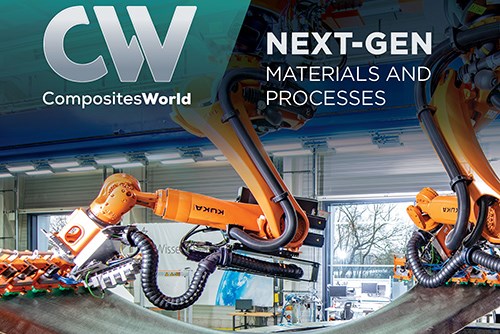Next-generation composites materials and processes explored
A supplement with the November 2020 issue of CompositesWorld takes a close look at some of the technologies that are driving innovation in the composites industry.

Top of Next-Gen Materials and Processes cover. Photo Credit: CW
CompositesWorld has published, with its November 2020 issue, a supplement titled “Next-Gen Materials and Processes” which reviews software, resin systems and manufacturing processes under development to meet the demands of emerging applications.
Coverage includes:
- Liquid molding vs. welded thermoplastic
- Reprocessable thermosets
- Automated fiber placement meets 3D printing
- Digital testing and qualification
- 3D printing with continuous fiber
- Ceramic matrix composites
- Future fuselage fabrication technologies
- Pressure vessels for hydrogen storage
- Next-generation composites qualification
Click here to access the digital edition of the “Next-Gen Materials and Processes” supplement.
Special thanks to the supplement’s sponsors:
- A&P Technology
- Adapt Laser Systems
- Airtech International
- CGTech
- Coastal Enterprises
- Composites Evolution
- Composites One
- Engineering Technology Corp.
- Norplex-Micarta
- Pacific Coast Composites
- Smart Tooling
- Toray Industries
Related Content
-
Eaton developing carbon-reinforced PEKK to replace aluminum in aircraft air ducts
3D printable material will meet ESD, flammability and other requirements to allow for flexible manufacturing of ducts, without tooling needed today.
-
Sulapac introduces Sulapac Flow 1.7 to replace PLA, ABS and PP in FDM, FGF
Available as filament and granules for extrusion, new wood composite matches properties yet is compostable, eliminates microplastics and reduces carbon footprint.
-
TU Munich develops cuboidal conformable tanks using carbon fiber composites for increased hydrogen storage
Flat tank enabling standard platform for BEV and FCEV uses thermoplastic and thermoset composites, overwrapped skeleton design in pursuit of 25% more H2 storage.












